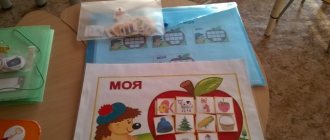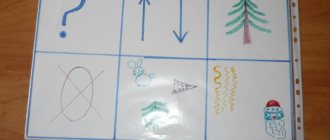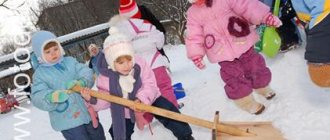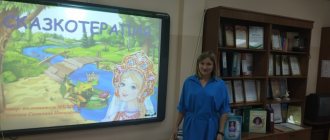Consultation for educators: “Speech development in older preschoolers”
knowledge of the norms and rules of speech etiquette, the ability to use them depending on the situation, and to be friendly.
In the process of developing coherent speech, children begin to actively use various types of connections between words within a sentence, between sentences and between parts of a statement, while respecting its structure.
At the same time, some children do not pronounce correctly all the sounds of their native language, do not know how to use intonation means of expression, or regulate the speed and volume of speech depending on the situation. There are also errors in the formation of various grammatical forms (genitive plurals of nouns, agreement of nouns with adjectives, different ways of word formation). A number of children have difficulty constructing complex syntactic structures, which leads to incorrect combination of words in a sentence and disruption of the connection between sentences in a statement.
In older preschool age, children continue to be introduced to the sound side of a word and a new type of work is introduced - familiarization with the verbal composition of a sentence. Forming in children the idea that speech consists of sentences, sentences - of words, words - of syllables and sounds, i.e. developing a conscious attitude towards speech is necessary to prepare preschoolers for mastering school literacy.
The range of educational tasks in relation to children of senior preschool age remains the same as at the previous stages, however, each task becomes more complicated both in terms of content and in terms of methodology.
Children learn to establish contact with unfamiliar adults and peers, answer questions kindly, be able to establish emotional contact, and engage in verbal communication with pleasure.
The development of speech and communication abilities is the most important task of developmental education and the cultivation of personal culture. Speech culture means not only mastery of the norms of the native language, but also the ability to use the expressive means of the native language in various communication conditions. This includes, on the one hand, the problem of correct speech, and on the other, the ability to choose from existing options the most appropriate in stylistic, semantic and situational terms.
Older preschoolers develop important skills - listening and understanding the speech of adults and peers, answering questions grammatically correctly, at the same time showing goodwill in communication, and participating in the conversation on their own initiative.
The nature of the child’s communication with the teacher and other children - initiative, the ability to enter into dialogue, maintain and conduct it consistently, the ability to listen to the interlocutor and understand him, clearly express one’s thoughts, use a variety of gestures, facial expressions, intonations and speech etiquette formulas - this is a clear characteristic of development speech and communication skills of older preschoolers.
Publication address:
Children of senior preschool age and speech creativity
The imagination of preschoolers differs from the imagination of adults. At this age, imagination is comparable to intellectual activity, which is aimed at changing the world around us. The baby “rises” above the situation and sees what is happening through the eyes of objects, fairy-tale characters and even phenomena.
Teaching creative storytelling is a difficult stage of work that forms a child’s coherent speech. Children learn to come up with a plot, course of events and denouement, describe the place and time of action, observe logical connections in the development of the plot, distinguish reality from fiction. Preschoolers imagine the characters' outfits, describe their character, facial features, and hairstyle. Provide your child with a field for creativity - endowing objects with magical powers, composing fairy tales, fantasizing, adapting a fictional character to life. The main characters of fairy tales are favorite toys and cartoon characters. A child easily compares himself with a fairy-tale character: girls dream of a dress like a princess, and boys dream of a cloak that gives magical powers.
When creating a fairy tale, the child independently makes a selection of events, drawing material from personal and literary experience. He also creates his own images of heroes, events, and draws a plot. With children of senior preschool age, they play out stories of a fairy-tale nature: “The Story of an Old Chest,” “The Adventures of Santa Claus in the Forest,” “My Favorite Cartoon.” The development of thinking has a positive effect on the development of the semantic side of a preschooler’s speech activity.
Such tasks develop imagination, improve vocabulary, and enrich the structure of speech. Science has proven that children’s understanding of the world is formed earlier than coherent speech. Often, during a retelling, the child strives to say more: as a result, he becomes silent, remembers, and selects words. Help your child translate words from passive to active vocabulary. To do this we use:
- Logic problems;
- Games for mastering gender categories;
- Games for the formation of figurative speech;
- Games for the development of personal business qualities;
- Games for the ability to find fables and true events in the text.
It is worth mentioning the acquaintance with children's literature and book culture. They don't read in the family, i.e. Children have no experience of family reading and active listening; the book is not valuable. The development of the child is carried out in a complete developmental environment. The natural environment is filled with sensory tools and play materials. In a group room, you can’t do without an audio and video library. Classes are held in a friendly environment.
Take into account one more methodological point - the speech activity of the teacher. At the same time, the teacher does not interfere with the child’s creativity, understands and accepts the child’s position. A preschooler teaches himself independently, relying on creativity and personal experience. Even a shy baby opens up.
At preschool age, children's speech is formed. During this period, speech requires attention from adults. Under its influence, views, consciousness, sense of will and character are formed. Cognitive processes are also improved with the help of speech. By the beginning of the first academic year at school, children have mastered the word-formation model of their native language, and the traditional norms of pronunciation of words are fixed in their heads.
Diagnosis of speech development in children of senior preschool age
In the preschool period, shortcomings in the child’s speech development become obvious. Delay in speech development negatively affects the baby’s behavior and activities. Disturbances in the child’s speech development are identified during diagnostic testing. Corrective work begins with diagnosis.
When examining a child, they analyze: the development of sound analysis, phonemic hearing, the composition and richness of the vocabulary, communication skills, and the grammatical structure of speech.
Diagnosis of children is carried out on the basis of diagnostic methods for examining different aspects of the speech of preschool children, recommended by O.S. Ushakova, E.A. Strebeleva, E.M. Strunina. Based on the diagnostic results, the levels of children's speech development are revealed: high, average, below average, low. Levels of formation reflect a set of universal educational actions that a kindergartener acquires after mastering the educational program. Diagnosis is carried out according to several criteria.
- Vocabulary : richness of vocabulary; the ability to select words that denote the qualities of an object; understanding the characteristics and qualities of an object.
- Sound culture of speech : auditory attention; the ability to distinguish vowels and consonants; the ability to characterize sounds in a word; the ability to combine sounds into groups.
- Grammatical structure of speech : the ability to describe an object (a picture from a book or a toy); the ability to create a description without visualization, based on life experience; ability to write a story based on pictures; ability to retell according to a pattern.
Techniques for the development of coherent speech : speech patterns, questions, explanations, motivated assessment of children’s answers and actions, skit games.
The literature describes methods for studying the coherent speech of preschoolers. Children are given tasks at the reproductive and productive levels. In the first case, the preschooler is given a template to retell or repeat. In the second, we use a toy or a picture from a magazine. The child creates an independent statement. When teaching, it is permissible to use 2-4 toys: in stories about games and play actions, the coherence of children's statements increases. At the beginning of teaching storytelling, ready-made game situations are used, which are played out by an adult.
Speech development indicators | |
| Mastery of a dictionary | Activation of adjectives and verbs. The ability to select words that are accurate in meaning in a speech situation |
| The ability to select antonyms and synonyms for given words of different parts of speech | |
| Ability to understand and use different meanings of polysemantic words | |
| Ability to differentiate general concepts (wild and domestic animals, etc.) | |
| Grammar | Ability to form names of baby animals |
| Ability to select cognate words | |
| Ability to agree nouns and adjectives in gender and number | |
| Ability to form difficult forms of the genitive case (hares, foals, lambs) | |
| Ability to form difficult forms of the imperative and subjunctive mood (hide, dance, look) | |
| Ability to construct complex sentences of various types | |
| Phonetics | Ability to differentiate pairs of sounds s-z, s-ts, sh-zh, l-r |
| Ability to distinguish between hissing, whistling and sonorant sounds | |
| Ability to distinguish between hard and soft sounds | |
| The ability to change the strength of the voice, tempo of speech, voice strength, intonation depending on the content of the statement | |
| Ability to select words and phrases that sound similar | |
| Connected speech | In retelling literary works, the ability to convey the dialogue of the characters and the characteristics of the characters |
| Ability to write descriptions, narrations and reasoning | |
| The ability to develop a storyline in a series of paintings, connecting parts of a statement using different types of connections | |
| General indicators of children's speech development | |
Speech development of children in older preschool age
Speech development is a designation of stages and techniques in a complex associated with mastering the means of speech, which are characterized by the development of verbal thinking, communication and creativity skills.
Speech is a dynamic phenomenon. Language does not stand still, but adapts to conditions and realities. Children feel these innovations better than us. The preschool stage is determined by intensive speech development. The children are making a leap in expanding their vocabulary. The speech became concrete and meaningful. At older preschool age, a child’s vocabulary already reaches 3-4 thousand words. During this period, children develop a “sense of language.” The young “linguist” intuitively senses the language norm. The child provides comments on the actions. Says: what am I doing now?
The growing needs of a preschooler act as a motive for language acquisition. The speech regulation function develops, which helps control activity and behavior. All activities are related to speech. The preschooler has new tasks and his social circle among peers and adults expands. It is important for a child to be understood by his interlocutors. The “little man” listens to people’s speech and copies the phrases and phrases he likes.
Observations play a role in vocabulary acquisition. The ability to see and feel the beauty of nature is formed during walks in the fresh air. Let them want to talk about the color of the clouds or the shape of the leaves on the trees! In the process of observation, children's vocabulary expands, and sentences acquire complex structures. .




